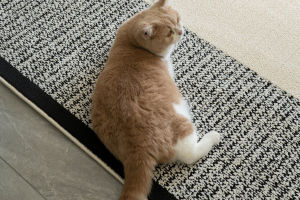Have you ever felt like your cat is ignoring you on purpose? Or that they only come to you when they want food? We've all joked about how "cold" cats seem compared to dogs.
But is this aloof behavior real—or just a misunderstanding of how cats express social connection? Let's explore the truth behind cats' "cool" image and decode their unique way of bonding.
Cats Are Not Dogs
First, we need to remember something important: cats and dogs are completely different species. Dogs are pack animals and naturally seek out social structure and approval. Cats, on the other hand, evolved to be more solitary. Their ancestors were mostly independent hunters, so their communication style is subtle and sometimes easy to miss.
That doesn't mean cats are cold. It just means they show affection in ways we might not expect. When we learn to understand their behavior, we start to see how social and attached they really are.
Slow Blinks Mean Love
One of the sweetest ways cats show trust and affection is through slow blinking. If your cat looks at you and slowly closes its eyes, it's actually saying, "I feel safe with you." It's a sign of love and trust in cat language.
We can even try this with our own cats—slowly blinking at them to say, "I trust you too." It's a peaceful, non-verbal exchange that deepens the bond between us.
Head Butts and Tail Flicks
Have you noticed your cat gently bumping their head against you? That's called head bunting, and it's a strong social gesture. Cats have scent glands on their heads, and when they rub on us, they're marking us as part of their social group. It's a very personal and affectionate action.
Similarly, a cat that wraps its tail around your leg or flicks it gently while walking by is greeting you warmly. It's their version of a casual, "Hey, I like you."
Following You Around
If a cat follows us from room to room or insists on sitting near us—even if it's just silently—it's not a coincidence. That's a cat's way of showing attachment. They may not always want to be picked up or petted, but just being nearby is their way of joining our little "group."
In fact, many cats feel safest when they're quietly included in what we're doing. Whether we're working on the couch or brushing our teeth, they're often close by, just watching.
Every Cat Is Different
Not all cats are equally outgoing. Just like people, they have different personalities. Some are naturally more affectionate, while others prefer more space and independence. It doesn't mean one cat is "cold" or another is "better"—they just connect in their own unique ways.
We've seen that even shy cats can form deep, meaningful bonds. They just take more time and need more patience. With trust, many of them will blossom into surprisingly social companions.
The Importance of Routine
Cats are creatures of habit. They form relationships over time and often feel more secure when life is predictable. We can build trust by keeping daily routines: feeding them at regular times, playing gently, and respecting their space when needed.
Consistency shows cats that we're reliable. That reliability builds emotional security, and from there, a cat's "social side" becomes easier to see.
Signs of Social Stress
Sometimes, what we think is aloofness might actually be stress or discomfort. For example, a cat that hides often, avoids eye contact, or hisses might be overwhelmed or feeling unsafe. That's why it's important to pay attention to changes in behavior.
Experts, including veterinarians and animal behaviorists like Dr. Mikel Delgado, suggest that a lack of social interest could signal anxiety, boredom, or past trauma. Understanding this can help us create a more comforting and welcoming home for our cats.
How We Can Help
To support our cats' social needs, we can offer safe spaces, interactive playtime, and positive attention. Try sitting near them while reading a book, or using a wand toy to gently invite them to play. Over time, these small actions make a big difference in the relationship.
Never force contact—cats prefer to make the first move. Instead, let them come to us. When they do, reward them with gentle pets or soft words. That way, we encourage trust while respecting their personality.
We're Part of Their World
Once we start to understand cat communication, we'll realize that their world is full of signals, routines, and quiet connection. A gentle purr, a slow blink, a head rub—they all carry meaning. We just have to pay attention and respond with care.
Cats aren't distant. They're just more subtle than we might expect. When we learn their language, we'll see that they've been trying to "talk" to us all along.
What About Your Cat?
Have you ever had a cat that seemed distant at first but slowly opened up? Or maybe one that always followed you around like a little shadow? We'd love to hear your stories. Every cat-human bond is special, and sharing them helps us all learn more about these fascinating companions.
The Myth of the "Cold Cat"
In the end, the idea that cats are cold and unsocial is just that—a myth. They're not ignoring us; they're showing affection in ways that fit their nature. Once we understand their social code, we'll see just how loving, loyal, and connected they can be.
So next time your cat gives you a slow blink or quietly curls up next to you, remember: that's their version of a warm hug. Let's enjoy the mystery and beauty of their unique way of saying "I love you."


